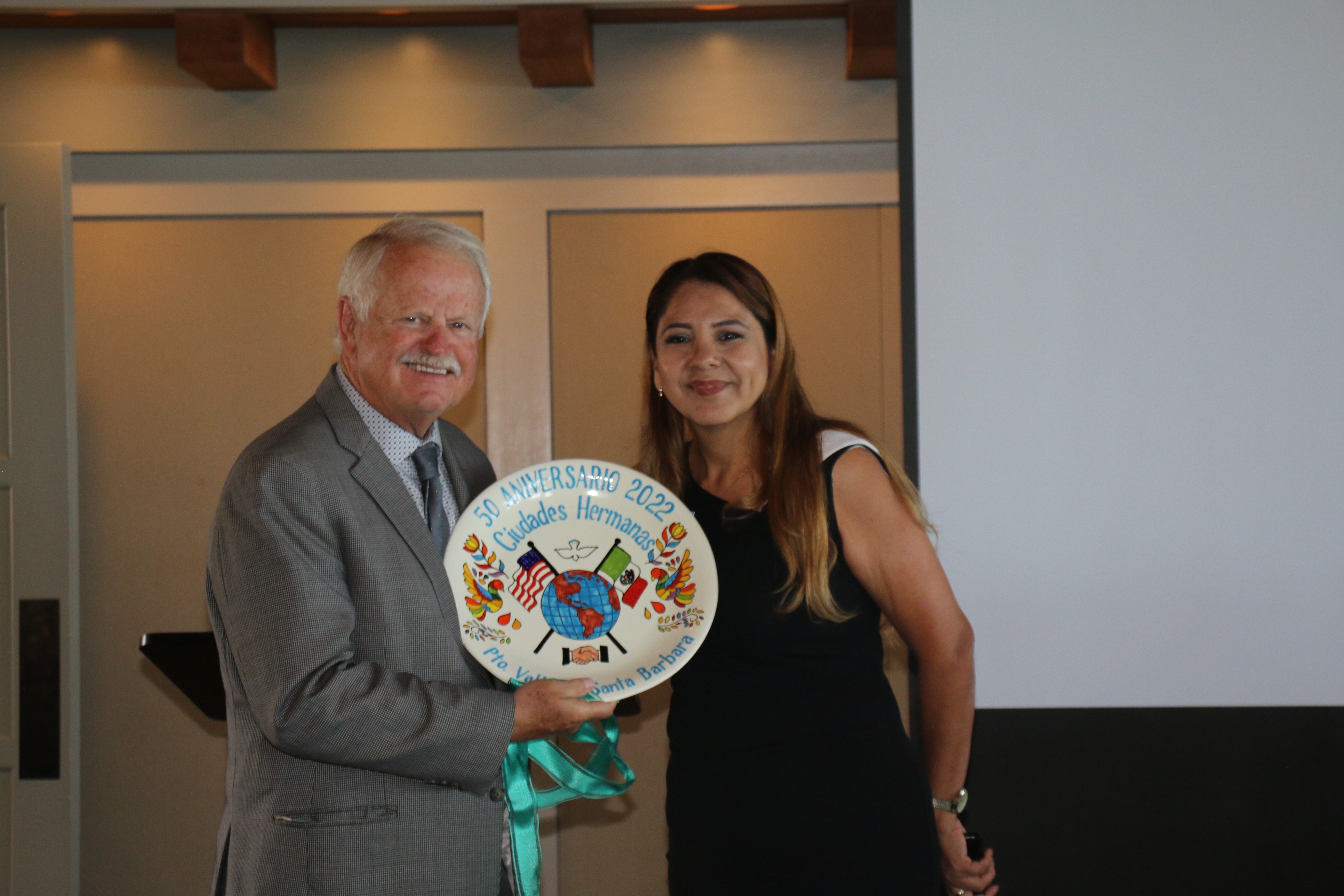HEALTH MINDED NEWS . . . .JPG)
Mayor Randy Rowse proudly signs Santa BArbara/Puerto Vallarta Sister City Reaffirmation Document at Santa Barbara City Hall (All photos by Bonnie Carroll LBN) SANTA BARBARA PUERTO VALLARTA SISTER CITIES REAFFIRMATION CELEBRATION 2022 By Bonnie Carroll for SB/PV Sister Cities .JPG)
Representative Emanuel Gallego from Consel General of Mexico, Mayor Randy Rowse, Raul Coultas Representative of Mayor of Puerto Vallarta (1).jpg)
Mayor Randy Rowse (middle) with Presidents' Sebastian Aldana and Irma Lorena Perez Coultas, Santa Barbara/Puerto Ballarta Sister Cities. During the recent reaffirmation celebration week, a delegation of Santa Barbara-Puerto Vallarta Sister City Committee Members and VIP guests from Puerto Vallarta Sister City Committee received a special blessing by Father Joe following Mass and Communion at the historic Old Mission Santa Barbara. The Puerto Vallarta delegation are visiting to celebrate 50 years as Sister City Members and to reaffirm their commitment as a Santa Barbara sister city. The Santa Barbara committee members hosted tours, parties and provided VIP introductions for the delegation during their week-long visit.  Presidents' Aldana & Coultas, Visiting VIPs & Santa Barbara/Puerto Vallarta Committee Members with Father Joe at Old Santa Barbara Mission The finale of the many hosted dinners, parties, and tours was the Santa Barbara-Puerto Vallarta Sister Cities Reaffirmation Ceremony in the Santa Barbara City Hall before a huge crowd of Puerto Vallarta VIP’s and Santa Barbara Sister City committee members, where Mayor Randy Rowse welcomed all and shared how pleased he was they visited Santa Barbara and how much he looked forward to visiting Puerto Vallarta. Pat Fallin, Chair of Sister Cities Board in Santa Barbara, welcomed guests and praised the fine work done by all the members over the past fifty years. Pat Fallin, Chair of Santa Barbara Sister Cities Board A bevy of proclamations changed hands in the historic Santa Barbara council chambers, Emanuel Gallego from the Office of the Consul of Mexico presented certificates of recognition. Irma Lorena Perez Coultas, President of the Puerto Vallarta-Santa Barbara Sister Cities shared her thanks and sense of purpose collaborating with Sister Cities, Sebastian Aldana, President of Santa Barbara-Puerto Vallarta Sister Cities expressed his pride in working with Sister Cities and his gratitude for all the Puerta Vallarta member contributions. Mayor Rowse then proudly signed the Reaffirmation Documents for the City of Santa Barbara and Raul Coultas, the immediate past President of the Puerto Vallarta group signed for Mayor Rodriguez of Puerto Vallarta who was unable to attend do to Covid in his family.  
1. Irma Loren Perez Coultas, President Puerto Vallarta/Santa Barbara Sister Cities Committe presents commorative Plate of Thanks to Santa Barbara Mayor Randy Rowse at City of Santa Barbara Luncheon, 2. Irma & Raul Coultas of Puerto Vallarta present Gil & Marti Garcia of Santa Barbara with Commorative 50th Anniversary thank you plate.
Following the Reaffirmation Ceremony Sister Cities members shared a delicious City of Santa Barbara hosted Mexican lunch by Mayos Carniceria & Tacos, a local Santa Barbara restaurant. Commemorative gifts were exchanged, and the Sister City Executive Board Members were all recognized. 
President Sebastain Aldana, guests & Emanuel Gallego enjoying City of Santa Barbara Sister Cities Celebration Luncheon Santa Barbara, and Puerto Vallarta, Mexico, are celebrating a cohesive and productive relationship of fifty years in 2022. This long-lasting relationship has had fruitful projects and exchanges during their time as sister cities, and they continually work to keep their bond strong, from educational programs to health initiatives. Bringing Good Health to Others: Through the years Santa Barbara and Puerto Vallarta have implement a variety of programs to improve their communities. They have jointly supported the Puerto Vallarta Rehabilitation Clinic since its inception in the 1980s, the Volcanes/Puerto Vallarta Sewing School, the Tomatlan Health Clinic, along with 19 years of Law Enforcement Exchanges with support provided to the Puerto Vallarta Police Academy, and a partnership with the International Firefighters Training Association (IFTA). For 16 years they have supported the I. Madonnari Street painting festival in Santa Barbara and assisted in creating a similar festival in Puerto Vallarta. They actively support the Sister Cities International Young Artists and Author Showcase (YAAS) and they also hold Annual Adult Visitation Exchanges between Santa Barbara and Puerto Vallarta. The Santa Barbara, California and Puerto Vallarta, México Sister Cities and the Rotary Club of Santa Barbara North assisted the Volances Food Bank in Puerto Vallarta during their COVID-19 crisis. In April, the two Sister Cities and the Rotary Club of Santa Barbara made a very generous donation to the food bank which went towards preparing food bags for 400 families. For information or donations please visit: www.sbpvsistercity.org . ___________________________________________________________________ 
_____________________________________________ Age-Related Macular Degeneration At a glance: AMD None Loss of the central vision you need to see details straight ahead, blurry or wavy areas in your central vision Dilated eye exam Dietary supplements (vitamins and minerals), injections, photodynamic therapy (injections and laser treatment) What is AMD? Age-related macular degeneration (AMD) is an eye disease that can blur your central vision. It happens when aging causes damage to the macula — the part of the eye that controls sharp, straight-ahead vision. The macula is part of the retina (the light-sensitive tissue at the back of the eye). AMD is a common condition — it’s a leading cause of vision loss for older adults. AMD doesn’t cause complete blindness, but losing your central vision can make it harder to see faces, read, drive, or do close-up work like cooking or fixing things around the house. AMD happens very slowly in some people and faster in others. If you have early AMD, you may not notice vision loss for a long time. That’s why it’s important to get regular eye exams to find out if you have AMD. What are the types and stages of AMD? There are 2 types of AMD: dry and wet. Most people with AMD have dry AMD (also called atrophic AMD). This is when the macula gets thinner with age. Dry AMD happens in 3 stages: early, intermediate, and late. It usually progresses slowly over several years. There’s no treatment for late dry AMD, but you can find ways to make the most of your remaining vision. And if you have late dry AMD in only 1 eye, you can take steps to protect your other eye. Wet AMD (also called advanced neovascular AMD), is a less common type of late AMD that usually causes faster vision loss. Any stage of dry AMD can turn into wet AMD — but wet AMD is always late stage. It happens when abnormal blood vessels grow in the back of the eye and damage the macula. The good news is that treatment options are available for wet AMD. What are the symptoms of AMD? The symptoms of AMD depend on the stage. Dry AMD happens in 3 stages: early, intermediate, and late. AMD is a progressive disease — that means symptoms usually get worse over time. - Early dry AMD doesn’t cause any symptoms.
- In intermediate dry AMD, some people still have no symptoms. Others may notice mild symptoms, like mild blurriness in their central vision or trouble seeing in low lighting.
- In late AMD (wet or dry type), many people notice that straight lines start to look wavy or crooked. You may also notice a blurry area near the center of your vision. Over time, this blurry area may get bigger or you may see blank spots. Colors may also seem less bright than before, and you may have more trouble seeing in low lighting.
Straight lines looking wavy is a warning sign for late AMD. If you notice this symptom, see your eye doctor right away. Am I at risk for AMD? Your risk for AMD increases as you get older. People age 55 and older are more likely to have AMD. The risk for AMD is also higher for people who: - Have a family history of AMD
- Are Caucasian
- Smoke
If you’re at risk for AMD because of your age, family history, or other factors, it’s important to get regular eye exams. Ask your doctor how often you need to get eye exams. Early AMD doesn’t have any symptoms, so don’t wait for your vision to change! How can I lower my risk for AMD? Research shows that you may be able to lower your risk of AMD (or slow vision loss from AMD) by making these healthy choices: - Quit smoking — or don’t start
- Get regular physical activity
- Maintain healthy blood pressure and cholesterol levels
- Eat healthy foods, including leafy green vegetables and fish
Did you know? AMD is very common — 11 million people in the United States have it Late AMD can happen in 1 or both eyes Having late AMD in 1 eye puts you at higher risk of developing late AMD in your other eye How will my eye doctor check for AMD? Eye doctors can check for AMD as part of a comprehensive dilated eye exam. The exam is simple and painless — your doctor will give you some eye drops to dilate (widen) your pupil and then check your eyes for AMD and other eye problems. Learn what to expect from a dilated eye exam Your doctor may also recommend doing a test called optical coherence tomography (OCT). In an OCT test, your eye doctor will take pictures of the inside of your eye with a special machine. What’s the treatment for AMD? Treatment for AMD depends on the stage and type. There’s currently no treatment for early AMD, so your eye doctor will probably just keep track of how your eyes are doing with regular eye exams. Eating healthy, getting regular exercise, and quitting smoking can also help. If you have intermediate AMD in 1 or both eyes, special dietary supplements (vitamins and minerals) may be able to stop it from turning into late AMD. If you have late AMD in only 1 eye, these supplements may slow down AMD in your other eye. Learn more about supplements for AMD If you have wet AMD, there are other treatments that may be able to stop further vision loss: - Medicines called anti-VEGF drugs that the doctor injects in your eye
- Photodynamic therapy (PDT), a combination of injections and laser treatment
Learn more about treatments for wet AMD There’s currently no treatment for late dry AMD — but researchers are hard at work looking for treatment options. And you can get support to help you live with vision loss from AMD. How do I live with vision loss from AMD? Not everyone with AMD develops late AMD or gets it in both eyes. But if you do, living with vision loss from AMD can be challenging. Having low vision means that even with glasses, contact lenses, medicine, or surgery, your vision loss makes it hard to do everyday tasks. The good news is, there are things that can help — like low vision devices and vision rehab services. Vision rehab can help you learn the skills you need to stay independent and activities. NATIONAL EYE INSTITUTE 2022 ___________________________________________ COVID-19 and Sex: What Men Need to KnowStudies have found that COVID-19 can cause erectile dysfunction and reduce male fertility in the months after infection. Medically Reviewed According to Chu, experts should continue to review new data as it comes out. “Looking for associations is an important first step, but we need to then identify these cause-and-effect correlations,” he says. It’s important to note that erections are not purely biological. “They require psychosocial factors and that needs to be looked at, too,” Chu says, explaining that the mental strain from being sick or even the stress of the pandemic might come into play. Scientists have long documented the toll that stress takes on libido and sexual function, but the research on how pandemic-related stress is affecting people’s sex lives has produced mixed results. A meta-analysis published in January 2022 in the journal BMC Public Health looked at 26 studies involving nearly 2,500 women and 3,800 men. Overall, the researchers found that there was an association between the COVID-19 pandemic and reduced sexual activity, especially in women, and that fear of contracting or transmitting COVID-19 had the greatest impact on the occurrence of sexual dysfunction. But a small study published in February 2021 in the journal Sexual Medicine, which included 76 male cannabis users, found that the pandemic didn’t appear to influence sexual function and actually increased sexual activity. Can COVID-19 Affect Male Fertility?The research on how COVID-19 may impact male fertility is also new, but a growing body of evidence suggests it might have a negative effect, at least in the short term. A study of 120 men published in February 2022 in the journal Fertility and Sterility found that 60 percent of those who’d had COVID-19 experienced reduced sperm motility (referring to sperm’s ability to move) in the month following infection, even though the virus was not detected in the sperm itself. Because the research is still new, it’s not clear how long this drop in fertility lasts, though the authors estimated around three months. A separate study, published in January 2022 in the American Journal of Epidemiology, included more than 2,100 couples. Researchers found that while COVID-19 in women didn’t appear to impair their ability to get pregnant, COVID-19 in men did seem to reduce fertility. Compared with males who did not have COVID-19 within the last 60 days, men who did were almost 20 percent less likely to conceive during that time frame. “We assume that the effects won’t be permanent but we don’t know that yet,” says Chas Easley, PhD, an associate professor of environmental health science at the University of Georgia School of Public Health in Athens, who was not involved with the research. According to Dr. Easley, all viruses target different receptors, or proteins, to gain entry into cells. The coronavirus behind COVID-19 targets two proteins: ACE2 and TMPRSS2. Easley and some other experts hypothesize that organs that contain both these proteins are particularly susceptible to infection by the COVID-19 virus. The testes, which are the organs responsible for making sperm, contain both. Sertoli cells, a type of cell in the testes, also contain these proteins. These cells form a physical barrier that separates blood vessels from the testes, called the blood-testis barrier. When the virus latches onto these proteins, it disrupts the function of Sertoli cells in multiple ways. “If you screw up the Sertoli cells, you lose the ability to promote the spermiogenesis required to create real sperm,” says Easley. He advises people who’ve had COVID-19 and are having difficulty conceiving to consider testing to evaluate sperm count and sperm motility. Do COVID-19 Vaccines Make Men Infertile?According to Easley, none of the COVID-19 vaccines reduce male fertility. “The vaccine can’t cause infertility — but the virus can,” he says. The study published in January 2022 in the American Journal of Epidemiology found no difference in male or female fertility among uninfected people who were vaccinated with the Pfizer-BioNTech, Moderna, or Johnson & Johnson COVID-19 vaccines compared with uninfected people who were not vaccinated. The new study backs up prior research on mRNA vaccines. An investigation published in June 2021 in JAMA, which included 45 men who received two doses of an mRNA COVID-19 vaccine, found that the vaccine did not lower sperm counts. In fact, sperm counts increased, from a median count of 26 million per milliliter at baseline to 30 million per milliliter after the second shot. According to Easley, getting vaccinated against COVID-19 is an important way for men to protect their fertility. "Even mild cases of COVID can lead to decreased sperm counts, lower sperm motility, and increased DNA fragmentation in sperm, and we predict that vaccines will prevent this damage," he says. Source: EverydayHealth.Com ___________________________________________________________________ The Finest in Independent LivingVISTA DEL MONTE 
Without the hassles of mundane chores, you’re free to enjoy the things you really want to do. At Vista del Monte, you’ll have time to engage in what’s most meaningful to you: pick up a new skill or hobby, travel, discover an interesting sport, or make more time to socialize. Whatever it is, we can help. With our Independent Living services, we take care of all the practical tasks, including transportation, housekeeping, and maintenance. Our culinary staff prepares delicious meals, handles all the day-to-day chores, and your wellbeing needs are attended to—all in one place. For information visit: www.vistadelmonte.org. Vista Del Monte – Santa Barbara, California – 805-687-0793
|


(1).jpg)





